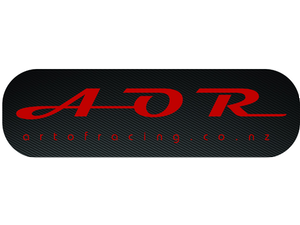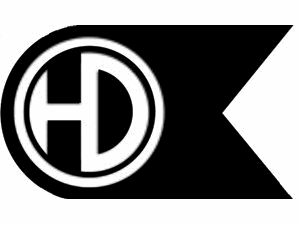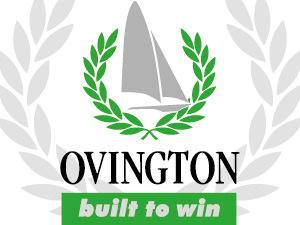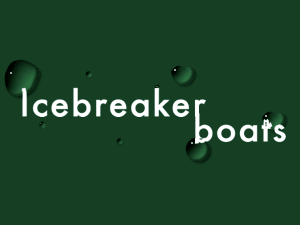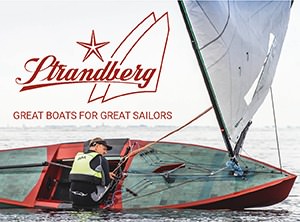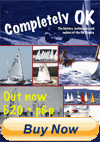You are here: okdia.org > technical > technical manual > side decks
Technical Manual
Ergonomics of Sidedecks
by Joe Whitwell
In spite of the many years over which we have known more or less how to build decent side decks on our boats, there are still to be seen an enormous number of boats with grotty side decks in our class.
No one who has sailed an OK for any length of time will be unaware of the importance of having comfortable side decks and a huge number of different variations have been produced, all of whose owners swear that they are good in much the same way, I feel, that so few proud owners of new cars are prepared to admit that they have made a bad choice!
So why not admit to yourselves at least, that your side decks are not the best in the world, or if they are, they are still uncomfortable on a long beat to windward. Then you may come at least part way down the road with me.
Way back some twenty years ago, the Finn sailors made a study of the sitting out posture. It was especially important to them because their very heavy boats and bodies were putting great stress on their legs and the incidence of the addition of the, then, new fangled weight jackets on top, had them really worried about possible physical damage.
They found even with weight jackets on top of body weights of 16-20 stones, that in the hooked hiking posture, the stress on the spine was still well under the loads likely to cause it damage. You are in more danger of hurting your back in launching and landing than during sailing, though previously damaged backs do sometimes give trouble.
The same however, could not be said for the knees where high leverage could cause some damage to the tendons and cartilage. In the course of this investigation, they found out that the minimum stress in the knee occurs when the inside angle between calf and thigh is at about 120°.
In OK, we are not as heavy as the Finn brigade and so are less likely to damage our knees. Neverthless, it is silly not to bear in mind the 120° angle for minimum stress.
On most OKs the knee angle is very much less than this. For example, on the "proven side deck" shown in fig. 1 the carlin is at 60° and the thigh plank at 45°. Thus the knee angle is only 75°. By the rule above this is much too steep and the knee is being "wedged apart" by the sharp angle.
The second consideration is the distance apart of the two angled planks. It can be argued that a narrow side deck allows the helmsman to get further outboard and so apply his weight more effectively. This is true, but HE MUST BE ABLE TO STAY THERE.
The point is that within reason, the further apart the planks are, the less is the load on the legs and stress on the knee. Try moving a Brazil nut up and down in your nut crackers and see where it breaks most easily!
Now think what happens on a long beat and think what is the major cause of your losing out and ceasing to concentrate and drive your boat as well as you did at the start. Is it not the pain in your legs that starts you to fidget and come in off the rail and tack unnecessarily?
So forget about that extra 1° of leverage and think instead about keeping down the leg stress and staying "fully set out" for three minutes longer than you have done before. Then you are thinking along the right lines.
Have you ever sat on a drawing pin? Ouch! It is enough to imagine it and you know what happens when you put all your weight on a very small area.
Assuming you have not yet torn your ligaments, the chief cause of discomfort and pain in your legs comes from slowing the flow of blood and oxygen to the muscles This is why it happens gradually. The starved muscles use up their supply of oxygen and begin to cry out for more and the pain increases as the reserves become less.
You could try hypnotism. but a better answer is to keep the blood flowing and not to stop it at points of high pressure. So we need to spread the load as much as we can on calf and thigh.
For reasonable comfort, the pressure needs to be spread over at least 10cms. Even this is not enough for prolonged periods, but it is a fair compromise. The next thing is to get as good a fit as possible between plank and leg so that the load is evenly spread without high spots of pressure.
Now let us apply these principles in practice and see what comes out. If we start by considering the angles we see that to make a knee angle of the ideal 120° leaves us with only 60° for the sum of the plank angles say 30° each side Compare this with the 60°, 45° of the 'proven side deck'.
If we put the carlin or calf plank as flat as 30°, we find the toe straps become very long and our feet are waving about high in the air. This is alright for the full stretch position, but it makes intermediate positions uncomfortable and extra effort is needed to get back into the boat. To correct this, the calf plank needs to be steeper than 30°. but it can only be made so at the expense of flattening the thigh plank further or of compromising the knee angle.
Let us now look at what is happening to your thighs. To simplify. we will assume that the thighs are a rigid bar carrying your weight W at a distance L from your knee K in the sketch in fig. 2. This is supported on the thigh plank over a short distance l from K to the gunwale G.
To simplify further. we will take the plank to be horizontal as it does not alter the principles. Now let us look at three ways the thigh can rest:
1) K is a small but finite distance above the plank. All the load is supported at the gunwale G. Many people sail like this.
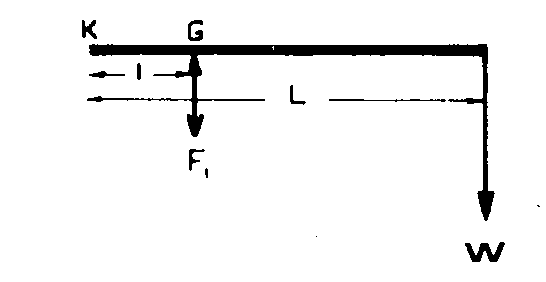
Taking moments about K
F1 x l= W x L
Or F1 = (W x L/l) = p1
2) Screw K down until it just touches the plank, but not so tight as put any pressure on the plank at K. The thigh bar is supported all across the plank with zero load at K and maximum load at G. We can represent the load by the triangle KGX and the centre of pressure comes at the centre of the area of the triangle:
2/3 of l from K.
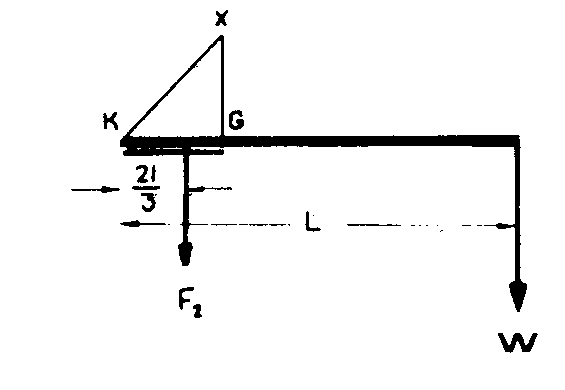
So we get
F2 = (3/2)xWx(L/l)
And p2 = F2 / (l/Z)
And p2 = 3 x W x (L/l²)
F2 > F1 but p2 < p1
3)K is tightened down until the load is the same right across the plank, represented by the rectangle KGYZ. The pressure centre is now in the middle, 1/2l from K.
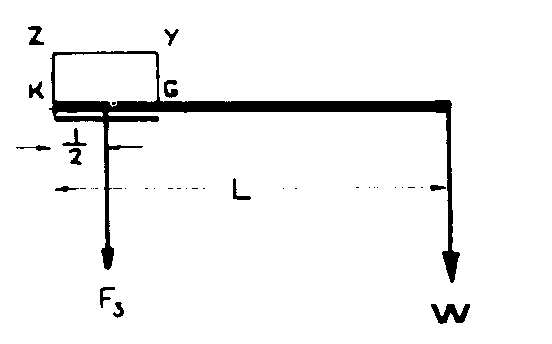
So we get
F3=2xWx(L/l)
All the loading is equal and
P3 = 2 x W x (L/l²)
F3 > F2 but p3 < p2
Let us put in some figures to make this theory meaningful.
Suppose you weigh 170lb (12 stone), your centre of gravity which lies at about the position of your coccyzx is 50 cm from your inside knee, the plank is 10cm wide and your thighs take up 30cm of rail.
CONDITION 1:
The load is on say 1cm width of rail.
Then pressure is
((170 x 50)/10)x(1/30) = 28lb/cm² . (OUCH!)
CONDITION 2:
Maximum pressure is on the rail and
p2 = (3 x 170 x 50) / (10² x 30) = 8.7lb/cm²
CONDITION 3:
Pressure is even over the whole plank and
P3 = (2x170x50)/(10²x30) = 5.7lb/cm²
In condition 3, the pressure is only 1/5 of that in condition 1, so you see how important it is to keep the knee pulled hard down onto the plank. Note how pressure is a function of the square of plank width and do not skimp on the outer plank.
Now that you know something about how to support your weight, you can turn to considering the toe strap. Its purpose of course is to stop the whole counter-weight contraption (you) from tumbling overboard. Yes, but it needs to apply the restraint correctly if you are to minimise pain. We all know don't we, that it must cross the instep not the toes, so as not to put stress on the foot. It must then first and foremost be able to apply a strong pull at right angles to the thigh plank so that the knee can be held down tight enough to approach condition 3 without the need for any muscular knee straightening effort which will use up oxygen and cause the onset of pain.
Second, if your thigh plank slopes. you will tend to slide outboard. This is checked by your calf coming up against the carlin. Now you have a lever, your calf with an outboard pull at the knee, an inboard thrust lower down from the carlin and a counter force from the toe strap to stop your muscles having to act to hold your leg in a bent position. This force should not be large; just large enough to stop your leg unhooking and allowing you to slide overboard. But the outboard positioning of the strap is important because it controls the angle of hook and hence whether the calf has even or point loading on the carlin.
To summarise, Outboard positioning controls calf loading; strap length controls thigh loading.
Now let us look at the thigh plank angle. Look at the diagram again in fig. 2 and think what happens when we rotate W downwards about K. The horizontal distance L from A to W is reduced and the thigh loading moment comes down BUT SO DOES THE RIGHTING MOMENT which provides the power. Also your bottom which was 12° only above smooth water, comes down and begins to hit the waves and stop the boat.
So do you need any angle at all?
Yes some angle is best because of two things:
- It allows you to slide quickly outboard and lock into the correct hiking position.
- For least stress of the stomach and back, the body should be balanced so that they are in the relaxed state with muscles neither bunched nor stretched and this entails a comfortable sitting posture with the knees raised slightly.
So far I have tried not to be dogmatic and say such and such is right. But now I will stick my neck out. I have made a trial sitting out bench with two planks, one 10cm wide which can be altered for angle and distance apart and with toe straps which are adjustable for position and length. It is made so that the sheer line is the correct height above water level, the floor, so I can also estimate wave clearance. I have tried all angles and distances between planks that the rule allows and adjusted toe straps for greatest comfort for each position. Without any doubt, the best answer for me came when the thigh plank was set at an angle of 30° to the horizontal and the carlin at 45° and when the distance between planks was close to the maximum that the rule allows But the effectiveness of the setting is critically dependant upon the toe straps being exactly right for the helmsman.
Let us end by looking at Pussy Pads. The official name in the new rule is 'Hiking Pads' and they work by distorting slightly under load so that they fit the contours of your legs. Thus it is the pads which distort instead of you, and load is spread without blood stopping compression. You can hike harder for longer.
To do their job, the pads must be firm, not soft and soggy, but with the right amount of yield. They should be light, rot proof and preferably resistant to uptake of water. One of the various plastic foams can be used. These are glued to the side decks and may generally be fairly easily shaped up in any way you fancy after which they are covered by a protective cloth to take the wear.
With this method, the actual side deck structure can be of the simplest as it forms only the base for the foam pads and no longer needs to be carefully shaped and formed. It should be made small enough to allow for a reasonable thickness of the foam and if of wood, sealed with epoxy resin to keep out the wet before the foam is glued on. When the foam disintegrates after a year or two it is easily renewed!
Illustrations
Note
Those whose eyes close when faced with mathematical equations may wish to turn to Joe's last four paragraphs!

